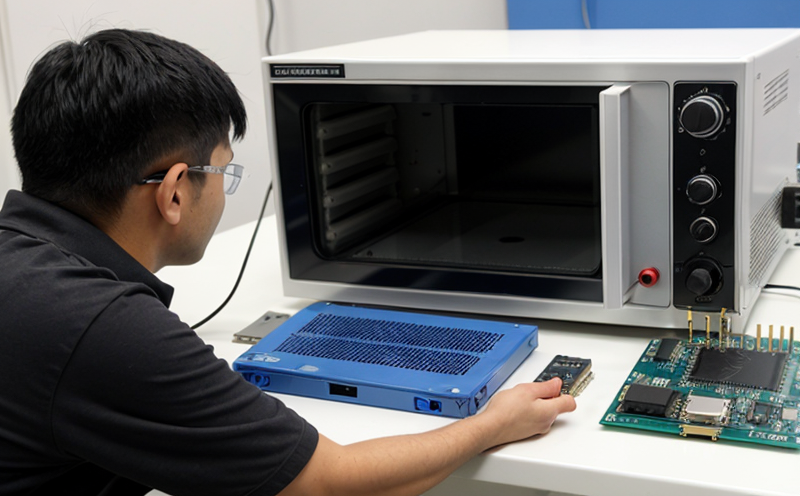ASTM F1192 Microelectronic Package Hermeticity Testing
The ASTM F1192 microelectronic package hermeticity test is a critical procedure used to determine the integrity of sealed electronic packages. This test ensures that the encapsulated components remain protected from environmental contaminants and moisture, which can otherwise lead to performance degradation or failure.
Hermetic sealing is essential in various sectors such as aerospace, automotive, medical devices, and consumer electronics where reliability under harsh conditions is paramount. The ASTM F1192 standard provides a method for evaluating the hermeticity of microelectronic packages by exposing them to helium gas and detecting leaks using mass spectrometry.
The test involves filling the package with helium at controlled pressure and temperature, then evacuating it while continuously monitoring for any helium loss. If no detectable helium is lost, the package passes the test; otherwise, it fails. This method allows engineers to identify potential flaws in the sealing process early on, ensuring that only fully hermetic packages are deployed.
The primary objective of ASTM F1192 testing is not just compliance with industry standards but also enhancing product reliability and longevity. By identifying and eliminating defects before mass production or deployment, manufacturers can avoid costly recalls and improve customer satisfaction.
For quality managers and R&D engineers involved in the design and manufacturing of microelectronic packages, understanding this test is crucial. Proper implementation ensures that each package meets stringent hermeticity requirements, thereby safeguarding sensitive components within.
| ASTM F1192 Test Parameters | Description |
|---|---|
| Helium gas pressure | Typically ranges from 50 to 300 kPa, depending on the package size and material. |
| Evacuation time | Varies based on the package type but generally between 1-2 minutes. |
| Mass spectrometer sensitivity | Absolutely necessary for detecting extremely low levels of helium loss. |
| Temperature control | Maintaining a stable temperature during testing to ensure accurate results. |
The test setup typically includes a vacuum chamber, helium gas source, mass spectrometer, and temperature control unit. Specimen preparation involves cleaning the package thoroughly to remove any surface contaminants that could interfere with the test results.
ASTM F1192 testing is particularly important for packages containing sensitive components like microcontrollers, sensors, or integrated circuits where even minute breaches can compromise functionality. The standard also applies to hermetically sealed connectors and sockets used in high-reliability applications.
The test procedure ensures that every package undergoes rigorous scrutiny before being incorporated into complex assemblies. This level of quality control is indispensable for maintaining trust with end-users who rely on these products' reliability and performance.
Scope and Methodology
- Fill the microelectronic package with helium gas to a specified pressure.
- Evacuate the chamber containing the package slowly while monitoring for helium leaks using mass spectrometry.
- Record any detected helium loss during evacuation.
- If no significant helium is lost, the package passes; otherwise, it fails.
The ASTM F1192 standard specifies detailed procedures for filling and evacuating the chamber, as well as the criteria for accepting or rejecting packages based on helium mass spectrometry results.
| Test Parameters | Critical Considerations |
|---|---|
| Helium gas purity | Purity of 99.995% or higher is recommended to minimize false positives. |
| Chamber pressure stability | Absolute pressure fluctuations should not exceed ±10 kPa throughout the test. |
| Mass spectrometer calibration | Regular recalibration ensures accurate detection of helium leaks. |
The ASTM F1192 standard also outlines specific acceptance criteria, which vary depending on the type and application of the microelectronic package. For instance, packages intended for aerospace applications may have more stringent requirements than those used in consumer electronics.
Benefits
- Enhances product reliability by identifying hermeticity issues early on.
- Promotes compliance with international standards, boosting market entry opportunities.
- Safeguards sensitive components from environmental contaminants.
- Reduces the risk of field failures and associated costs.
- Supports the development of high-reliability microelectronic packages suitable for demanding environments.
- Aids in meeting regulatory requirements, ensuring safety and performance standards are met.
The ASTM F1192 test plays a pivotal role in maintaining the integrity of microelectronic packages across diverse industries. By adhering to this standard, manufacturers can ensure that their products meet the highest quality benchmarks, thereby building customer confidence and trust.
Environmental and Sustainability Contributions
The ASTM F1192 microelectronic package hermeticity testing contributes positively to environmental sustainability by ensuring the longevity of electronic devices. By preventing premature failure due to moisture or other contaminants, this test helps reduce waste associated with discarded products that do not meet expected lifespans.
Moreover, compliance with this standard aids in meeting broader environmental regulations aimed at reducing the ecological footprint of electronics manufacturing processes. Through enhanced product reliability and reduced replacement rates, manufacturers can contribute to more sustainable practices within their industry.
The rigorous testing process also promotes the use of durable materials and construction methods that are less prone to environmental degradation, further supporting sustainability goals.





